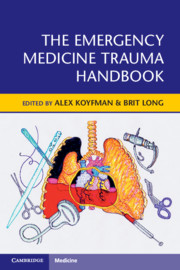Book contents
- The Emergency Medicine Trauma Handbook
- The Emergency Medicine Trauma Handbook
- Copyright page
- Contents
- Contributors
- Preface
- Disclaimer
- Chapter 1 General Approach to Traumatic Injuries
- Chapter 2 Trauma Airway
- Chapter 3 Transfusion in Trauma
- Chapter 4 Trauma in Pregnancy
- Chapter 5 Pediatric Trauma
- Chapter 6 Geriatric Trauma
- Chapter 7 Head Trauma
- Chapter 8 Facial Trauma
- Chapter 9 Eye Trauma
- Chapter 10 Cervical Spine Trauma
- Chapter 11 Thoracolumbar Trauma
- Chapter 12 Neck Trauma
- Chapter 13 Pulmonary Trauma
- Chapter 14 Cardiac Trauma
- Chapter 15 Abdominal and Flank Trauma
- Chapter 16 Genitourinary Trauma
- Chapter 17 Peripheral Vascular Injury
- Chapter 18 Pelvic Trauma
- Chapter 19 Upper Extremity Trauma
- Chapter 20 Lower Extremity Trauma
- Chapter 21 Burns and Electrical Injuries
- Chapter 22 Procedural Sedation and Analgesia in Trauma
- Chapter 23 Commonly Missed Traumatic Injuries
- Index
- References
Chapter 17 - Peripheral Vascular Injury
Published online by Cambridge University Press: 23 August 2019
- The Emergency Medicine Trauma Handbook
- The Emergency Medicine Trauma Handbook
- Copyright page
- Contents
- Contributors
- Preface
- Disclaimer
- Chapter 1 General Approach to Traumatic Injuries
- Chapter 2 Trauma Airway
- Chapter 3 Transfusion in Trauma
- Chapter 4 Trauma in Pregnancy
- Chapter 5 Pediatric Trauma
- Chapter 6 Geriatric Trauma
- Chapter 7 Head Trauma
- Chapter 8 Facial Trauma
- Chapter 9 Eye Trauma
- Chapter 10 Cervical Spine Trauma
- Chapter 11 Thoracolumbar Trauma
- Chapter 12 Neck Trauma
- Chapter 13 Pulmonary Trauma
- Chapter 14 Cardiac Trauma
- Chapter 15 Abdominal and Flank Trauma
- Chapter 16 Genitourinary Trauma
- Chapter 17 Peripheral Vascular Injury
- Chapter 18 Pelvic Trauma
- Chapter 19 Upper Extremity Trauma
- Chapter 20 Lower Extremity Trauma
- Chapter 21 Burns and Electrical Injuries
- Chapter 22 Procedural Sedation and Analgesia in Trauma
- Chapter 23 Commonly Missed Traumatic Injuries
- Index
- References
Summary
Peripheral vascular injury (PVI) is a major concern in the Emergency Department (ED). According to the CDC, there were 33,594 mortalities related to firearms in 2014.1 There were 803,007 cases of aggravated assault that occurred in 2016. Nearly 24% of these (190,000) were performed with firearms and 16% (120,000) with cutting instruments.2 Inevitably, many of these result in damage to the vasculature, leading to blood loss and presentation to the ED. While some forms of injury are immediately life threatening and require emergent intervention, some present asymptomatically, which can lead to delayed or missed diagnoses. Emergency physicians should be well versed in the diagnosis, management, and disposition of these patients. This chapter will focus on the management of penetrating extremity trauma with vascular injury.
- Type
- Chapter
- Information
- The Emergency Medicine Trauma Handbook , pp. 249 - 259Publisher: Cambridge University PressPrint publication year: 2019



